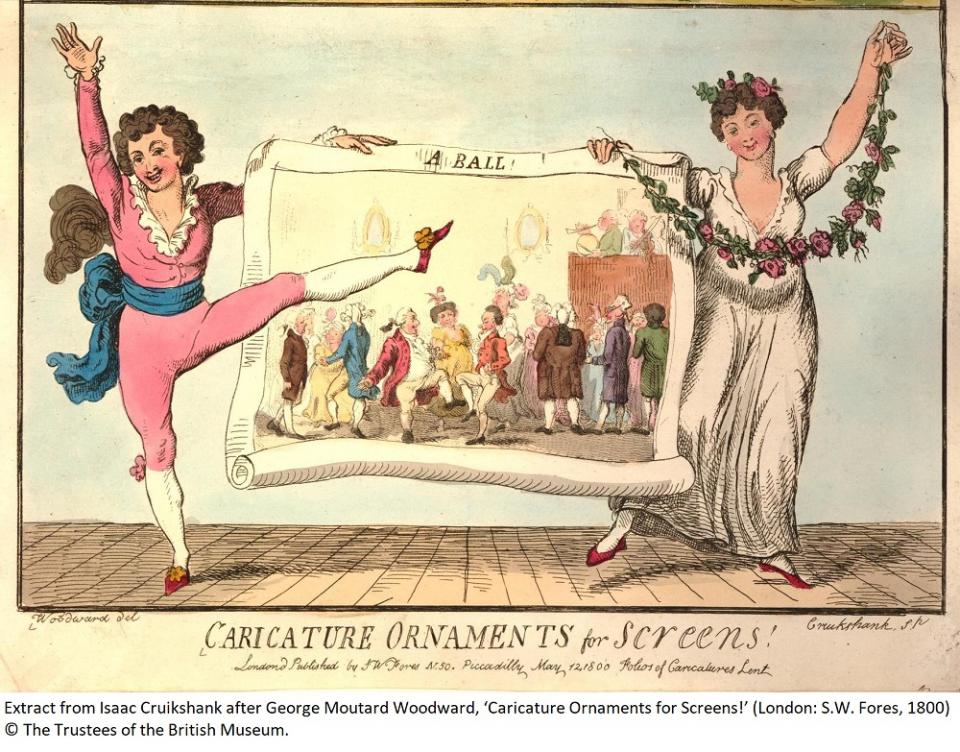
Theatrical and Social Dance
Theatrical and social dance were closely related with myriad connections and interactions between the two genres across the eighteenth century and beyond. The most fundamental of these connections lay in the aesthetics of body movement. The ideal of graceful and elegant deportment as cultivated by the upper classes infused social dance, permeated the polite gestures of aristocratic life beyond dance and impacted the training of stage dancers. This created a continuity of movement style (including a shared heritage in the use of steps) and performative actions across the social-theatrical continuum. This shared vocabulary of movement reached across disciplines to touch not only actors and other theatre artists but also those in professional occupations such as law. Such integration and understanding of movement ensured that dance could facilitate a nuanced, expressive conversation between spectators and performers, and that these roles were fluid depending upon context (Nevile 2019; Noll Hammond 2007; Smith 2014).
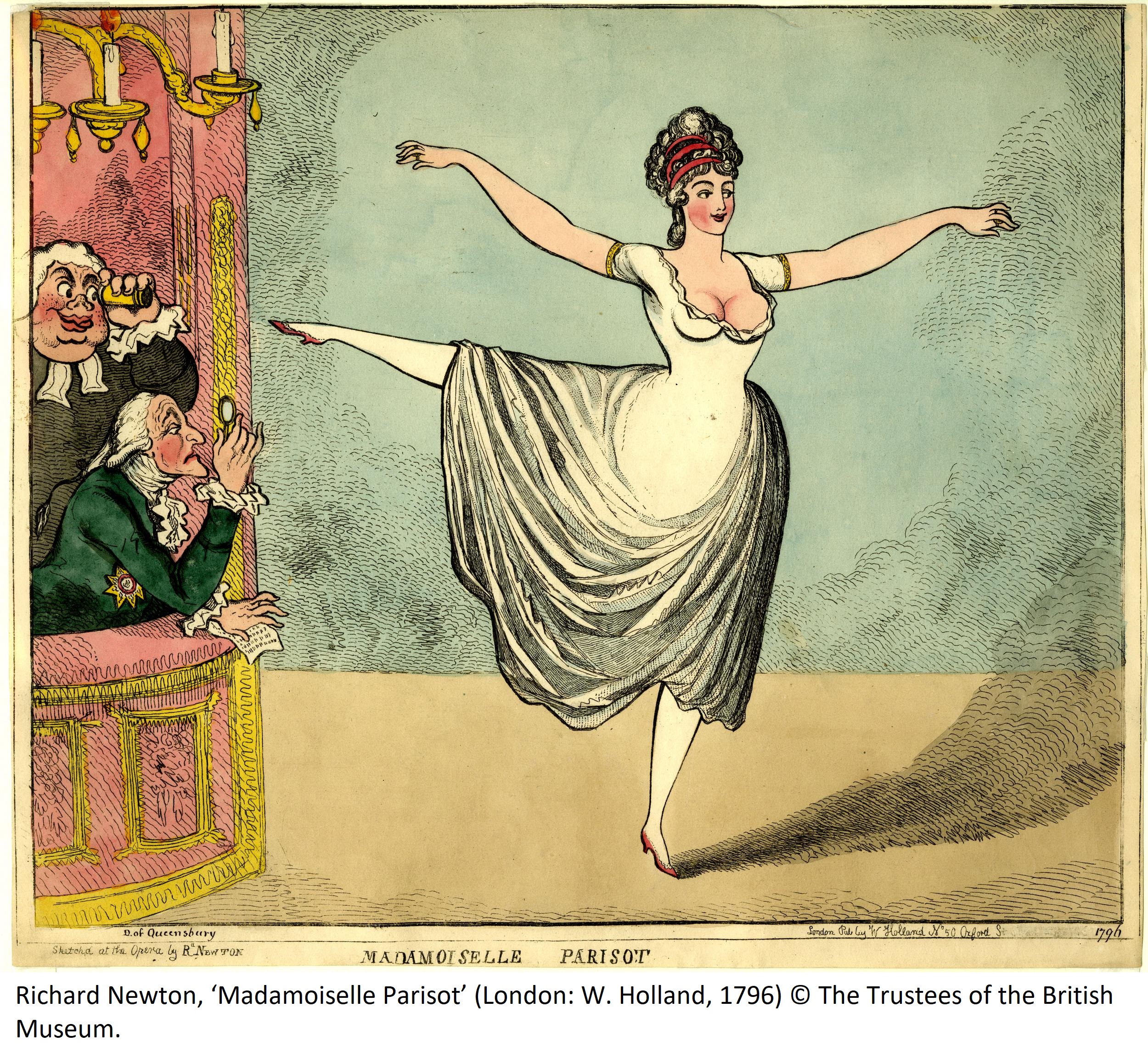 Despite these connections there was at times considerable nervousness about the infiltration of theatrical style into social dance. John Weaver recognised that “altho’ the Steps of both are generally the same, yet they differ in the Performance”, as actions on stage required projection and exaggeration to be perceived, and some manoeuvres were suited only to stage dancing, including capers, pirouettes and “almost all Steps from the Ground” (Weaver 1712, 162-163). Many nineteenth-century authors objected to the size and athleticism of the motions employed by professional dancers, the “largeness of the movements, the unceasing pirouetting, the ungracefulness of many of the attitudes, the unnatural turning out of the legs” considered unsuitable for the genteel ballroom (Webster 1851, 5). In 1829, The Young Lady’s Book declared that:
Despite these connections there was at times considerable nervousness about the infiltration of theatrical style into social dance. John Weaver recognised that “altho’ the Steps of both are generally the same, yet they differ in the Performance”, as actions on stage required projection and exaggeration to be perceived, and some manoeuvres were suited only to stage dancing, including capers, pirouettes and “almost all Steps from the Ground” (Weaver 1712, 162-163). Many nineteenth-century authors objected to the size and athleticism of the motions employed by professional dancers, the “largeness of the movements, the unceasing pirouetting, the ungracefulness of many of the attitudes, the unnatural turning out of the legs” considered unsuitable for the genteel ballroom (Webster 1851, 5). In 1829, The Young Lady’s Book declared that:
“it would be in the extreme of bad taste for the ball-room dancer to attempt the least brilliant of those embellishments to “the poetry of motion,” which are displayed by the dancer on the stage” (396).
We can be certain that, in practice, cross-over between the two genres occurred due to intermittent discussion of the topic in dance manuals. Edinburgh dancing master Barclay Dun, quoting from The Mirror of the Graces (1811), complained bitterly about the impropriety of young ladies imitating the attitudes of theatrical dance and incorporating ballet dances into their repertoire, while thirty years later another author indicated that “extreme positions” from the stage were still being taught by dancing masters who were previously attached to the theatre (Dun 1818; Webster 1851).
If similar bodily movement penetrated both social and theatrical realms, there was also a very real interchange of dances and dancers between the stage and the ballroom. In France, the beating heart of European dance, serious dance comprised both social and theatrical court entertainments, leading to a distinct intermingling of personnel: trained amateurs and professional dancers appeared together in court ballets while dancing masters partnered elite women at court balls (Hilton 1997; Nevile 2019). Bal masqués incorporated choreographed and rehearsed masquerades that were interspersed within a ball (Semmens 2004). Choreographers also created dances intended for both stage and ballroom. Raoul-Auger Feuillet’s Chorégraphie ou l’art de décrire la dance (1700), one of the earliest collections of notated dance, demonstrated such fluidity – Feuillet, who taught social dance in Paris, provided several theatrical dances for the publication, while Louis Guillaume Pécour, ballet master and choreographer at the Paris Opéra, contributed ballroom dances to the collection. 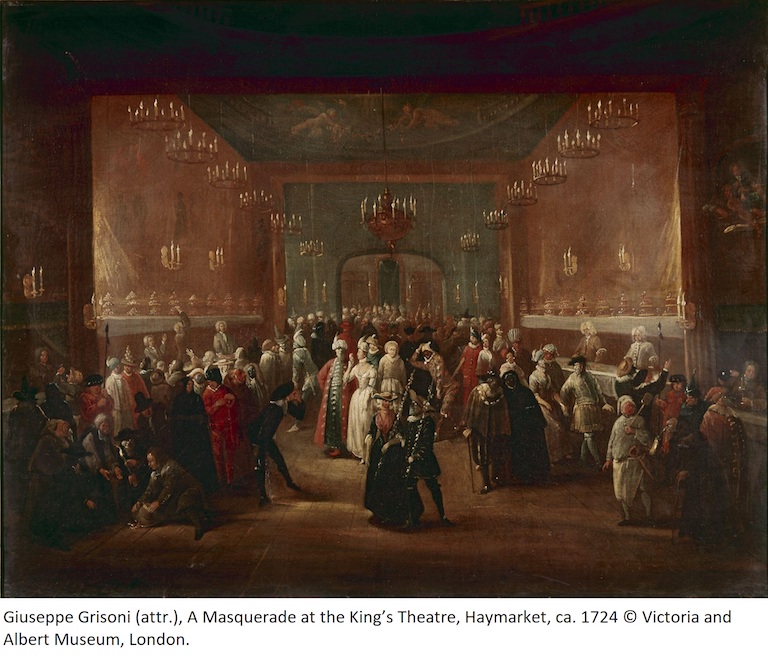 The influence of French dance was widely felt, including in Britain, where Feuillet’s Chorégraphie was produced in translation in 1706 (Craine and Mackrell 2010; Hilton 1997; Little 2001).
The influence of French dance was widely felt, including in Britain, where Feuillet’s Chorégraphie was produced in translation in 1706 (Craine and Mackrell 2010; Hilton 1997; Little 2001).
Dance was integral to the English theatrical experience and comprised divertissements between acts of plays and operas, as well as full-length ballets, in addition to variety-type acts that included rope dancers. London was a hub which drew international choreographers and dancers, and the theatre saw social dance migrate into and out of its space (Smith 2014; Thorp 2008). Dancing masters were one of the crucial bridges connecting stage and ballroom. Some were principal dancers and ballet masters who taught and published on social dance (Bloomfield and Watts 2008; Engelhardt 2009). Giovanni Battista Gherardi, for example, trained dancers who appeared at the Haymarket and Drury Lane theatres, but he also taught social dance to London’s elite through his own academy. In this way, the dancing master played a crucial role in creating a body aesthetic which was important for both professional and amateur dancers. The theatre as a building also hosted balls – in Paris, public balls were held at the Opéra, sometimes in aid of benefits for dancers and singers, and often on the same day as theatre performances, while in London, Johann Jakob Heidegger held masquerade balls at the King’s Theatre. It is important to note that such events occasioned changes to the theatre itself, including alterations to the stage, which sometimes prevented sets from being used during opera performances (Semmens 2004).
This bleeding of social dance into the theatre also occurred as part of dramatic entertainments. In the late 1740s, David Garrick incorporated a masquerade and ball into his production of Romeo and Juliet at Drury Lane (Smith 2014). Nearly a century later, Daniel Auber’s opera Gustave III, ou Le bal masqué premiered at the Paris Opéra and featured a spectacular ball scene with more than one hundred dancers performing a galop (Clark 2005).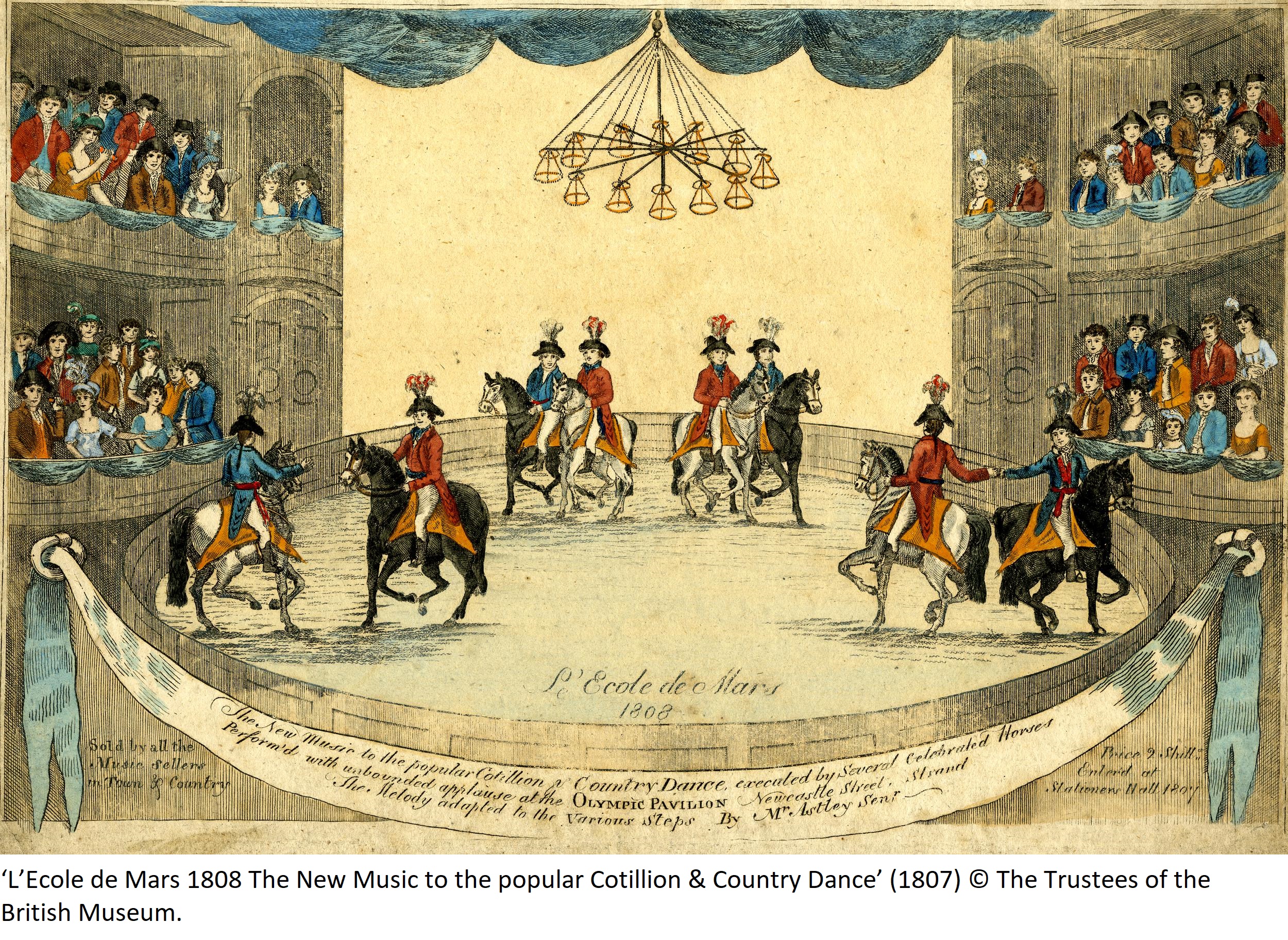 When the opera was produced at Covent Garden theatre, numerous members of the aristocracy (including the Duchess of Kent and Princess Victoria) were in the audience and many of them joined “in the Ball in masks”, blurring the line between spectator and performer (Morning Post 25 November 1833).
When the opera was produced at Covent Garden theatre, numerous members of the aristocracy (including the Duchess of Kent and Princess Victoria) were in the audience and many of them joined “in the Ball in masks”, blurring the line between spectator and performer (Morning Post 25 November 1833).
Dances also migrated between social and theatrical spaces, with the theatre playing a role in potentially disseminating new dances (Clark 2005; Nevile 2019). The actress and dancer Hester Santlow performed minuets in addition to distinct theatrical genres such as Harlequin dances at Drury Lane theatre (Noll Hammond 2007). A benefit performance for Gherardi at the Haymarket theatre in 1761 not only included dances of his own choreography but also a minuet which he danced with the singer and dancer Jane Poitier [Mrs Vernon], referred to as “the liveliest baggage on the modern stage” (Baldwin and Wilson 2002). In 1768 a cotillion was inserted into the play The National Prejudice for Mrs Abington’s benefit at Drury Lane theatre, while minuets, cotillions, hornpipes and country dances were part of the equestrian repertoire on offer at Astley’s circus, which additionally included performances of ballet (Kwint 1994). The process also worked in reverse and in the case of the polka prompted a veritable collision, with ballet fans reproducing the costumes of professional dancers in their own dance spaces, while the polka itself was subsequently integrated into plays (Engelhardt 2009; Smigel 1996).
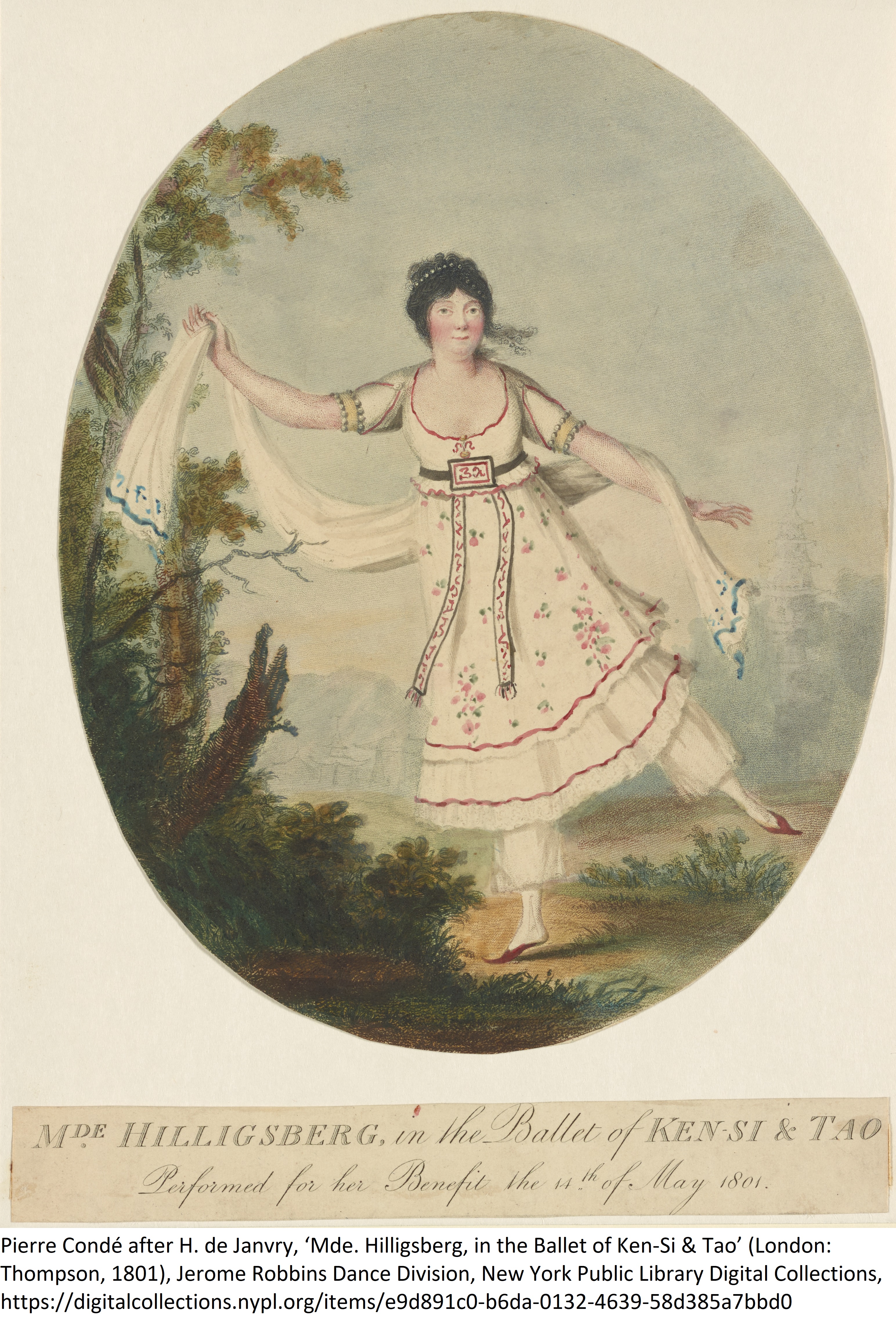 These kinds of transferences also played out in published music. The ballet Little Peggy’s Love was staged at the King’s Theatre on 21 April 1796 and premiered between the acts of an opera in a benefit performance for the dancer, Madame Hilligsberg. The score was published by Longman and Broderip around three weeks later and by November one of the dances that occurs late in the ballet appeared on The New Dance Fan for 1797 as a country dance. However, another dance on the same page of the ballet score is derived from William Marshall’s A Collection of Strathspey Reels, published in 1781, under the title of Lady Louisa Gordon’s Reel. This dance in turn was relabelled as Miss Farquharson (of Invercauld’s) Strathspey, with minor alterations, in Robert Petrie’s A Second Collection of Strathspey Reels, produced the same year as the ballet. The movement of social dance in and out of the ballet was not an isolated example, and the rise of the quadrille in the nineteenth century saw many dances based on opera and ballet music.
These kinds of transferences also played out in published music. The ballet Little Peggy’s Love was staged at the King’s Theatre on 21 April 1796 and premiered between the acts of an opera in a benefit performance for the dancer, Madame Hilligsberg. The score was published by Longman and Broderip around three weeks later and by November one of the dances that occurs late in the ballet appeared on The New Dance Fan for 1797 as a country dance. However, another dance on the same page of the ballet score is derived from William Marshall’s A Collection of Strathspey Reels, published in 1781, under the title of Lady Louisa Gordon’s Reel. This dance in turn was relabelled as Miss Farquharson (of Invercauld’s) Strathspey, with minor alterations, in Robert Petrie’s A Second Collection of Strathspey Reels, produced the same year as the ballet. The movement of social dance in and out of the ballet was not an isolated example, and the rise of the quadrille in the nineteenth century saw many dances based on opera and ballet music.
Away from the public theatres, private theatricals offered the chance to combine social and stage dance in varying degrees. As part of Twelfth Night celebrations in 1799, the Countess of Shaftesbury held an entertainment at her home in Portland Place which included a performance of Little Peggy’s Love in a purpose-built theatre; it was under the direction of Madame Hilligsberg and featured her pre-teenage daughter, while the evening was finished off with a ball. 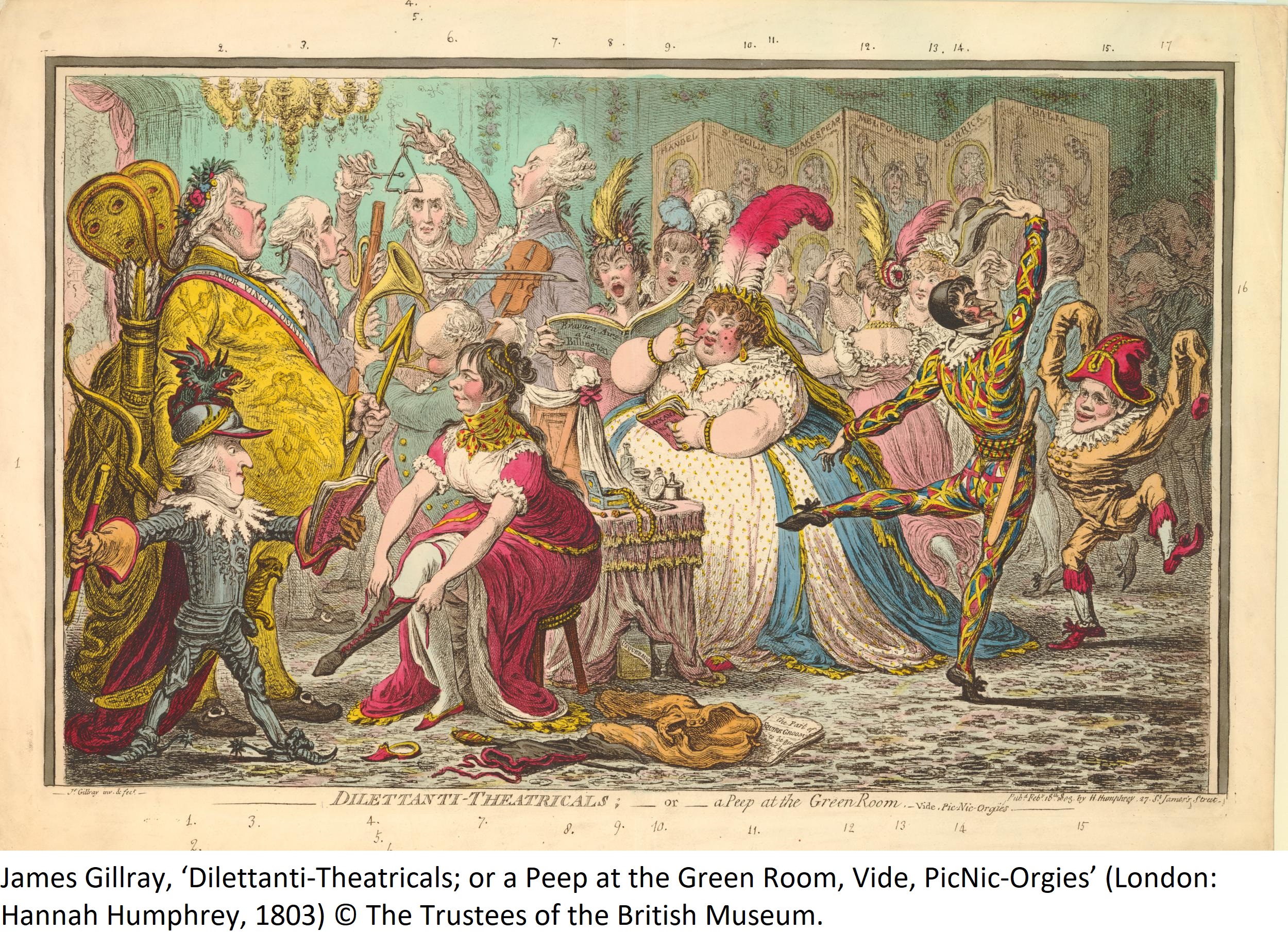 Some theatrical productions incorporated social dance directly into the entertainment – at Blenheim Palace in 1788, a performance of The Maid of the Oaks finished with a ballet which included a minuet, while at Burton Constable in 1843 private theatricals comprising tableaux, a scene from Romeo and Juliet, and the comedy Simpson and Co. concluded “with a Quadrille by the characters” (Hull Packet and East Riding Times 17 February 1843). This also applied offshore, where a hornpipe (which historically encompassed both social and theatrical genres) was sandwiched between performances of Wild Oats and The Mayor of Garrett on board the Bulwark off the coast of France in 1813 (Rodger 2005).
Some theatrical productions incorporated social dance directly into the entertainment – at Blenheim Palace in 1788, a performance of The Maid of the Oaks finished with a ballet which included a minuet, while at Burton Constable in 1843 private theatricals comprising tableaux, a scene from Romeo and Juliet, and the comedy Simpson and Co. concluded “with a Quadrille by the characters” (Hull Packet and East Riding Times 17 February 1843). This also applied offshore, where a hornpipe (which historically encompassed both social and theatrical genres) was sandwiched between performances of Wild Oats and The Mayor of Garrett on board the Bulwark off the coast of France in 1813 (Rodger 2005).
Performances of Charles Dibdin’s comic opera, The Padlock, by the Bridgeman family additionally highlight how theatrical dance could act as an instigator for social dance. Gherardi’s Third Book of French Country Dances or Cotillons, dated October 1770, was dedicated to Lady Bridgeman, likely to have been Elizabeth Simpson, who married Sir Henry Bridgeman, 5th Baronet, of Weston Park in Shropshire in 1755. His supplicatory dedication outlined how two of the dances within the collection were specifically created as a homage to Lady Bridgeman’s production, in which his pupils (her children) performed his choreography:
“And in order to engage your Ladyship still more willingly to accept this Instance of my zeal in my Profession, I have composed and placed in it, two new Dances which I call the Mungo and the Padlock. These I composed in consequence, and commemoration, of the dramatic petit piece of the Padlock, presented at your House, under your conduct and direction; in which my deserving little Pupils so agreeably surprized their honourable Audience; not only in the Reciting-part of the Comedy, but likewise in the Execution of the Allemandes, and in the Dances I composed for them on the occasion” (Gherardi 1770, II-III).
The Padlock was first performed by the Bridgeman family in 1770 at their home in St. James’s Square, possibly in direct competition with Drury Lane, while two later performances were given at Weston Park (Perkins 2020). Gherardi’s use of dance within the production, and his appropriation of music directly from the opera to create the two cotillions, speaks to how theatrical dance could be seamlessly wedded to social dance beyond the public stage.
